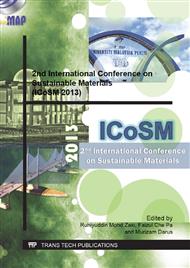p.324
p.329
p.334
p.338
p.343
p.347
p.352
p.356
p.360
Effect of Compaction Pressure on Microstructure and Properties of Copper-Based Composite Prepared by Mechanical Alloying and Powder Metallurgy
Abstract:
In this study, copper-tungsten carbide composite was produced by mechanical alloying and powder metallurgy. The compaction pressures were varied from 100 to 600 MPa for observation on microstructure and properties of the composite. The result showed the microstructure was densified with the increased of compaction pressure. Within compaction pressure no fracturing was occurred. Increasing compaction pressure increased the density, hardness and electrical conductivity of the composite which related to the reduced of porosity area.
Info:
Periodical:
Pages:
343-346
Citation:
Online since:
September 2013
Authors:
Price:
Сopyright:
© 2013 Trans Tech Publications Ltd. All Rights Reserved
Share:
Citation:


